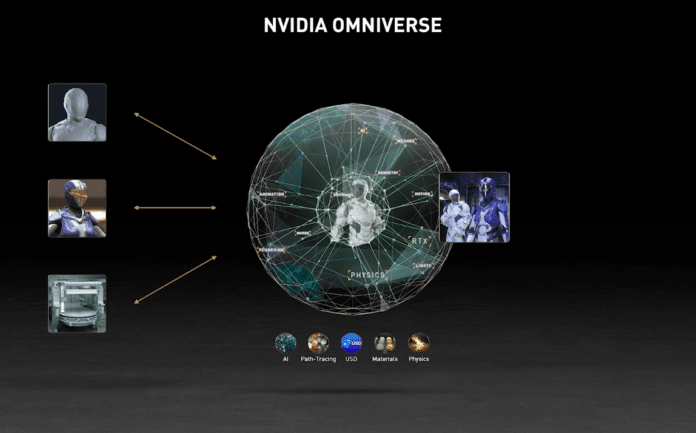During his opening keynote address at NVIDIA GTC, the company’s Founder and CEO Jensen Huang characterized artificial intelligence (AI) and 5G as “ingredients” necessary to “kickstart the fourth industrial revolution.” He added, however, that we are still in need of a final “miracle.”
Cue the NVIDIA Omniverse.
Described by Huang as similar to the metaverse in Neal Stephenson’s sci-fi novel Snow Crash, the Omniverse was first released in its Beta phase in Decemeber 2020 and is a virtual environment built on “NVIDIA’s entire body of work.” The platform lets engineers “create and simulate shared virtual 3D worlds” that are physically based, with the physics simulated with NVIDIA PhysX and the materials simulated with NVIDIA MDL.
“There are several major parts of the platform,” Huang said. “First, the Omniverse Nucleus: A database engine that connects users and enables the interchange of 3D assets and scene descriptions.”
Inside the shared virtual space, multiple designers can collaboratively create a scene by transmitting and receiving Universal Scene Description (USD) snippets.
“The second part of Omniverse,” Huang continued, “is the composition, rendering and animation engine: The simulation of the virtual world.”
Huang called the third part of the Omniverse, NVIDIA CloudXR, a sort of stargate that allows users to use virtual reality (AR) to “teleport into Omniverse” and AI to use augmented reality (AR) to “teleport out.”
The applications for Omniverse seem varied and endless, from video game creation to factory and building design to creating a digital twin of the entire planet, as Twin Earth is currently doing.
Ericsson, revealed Huang, is using Omniverse to simulate real-time 5G wave propagation with many multi-path interferences. In a blog post, Ericsson described this project further, explaining that it’s using the platform’s ray tracer in conjunction with the interactive tools to “manipulate and explore complex scenes,” which allows the company to experiment with product placement and explore the impact on RF transmission of that placement in real time.
“NVIDIA Omniverse is an extensible platform centered on its Nucleus scene database. Integrations with other simulation assets are possible at various levels and our 5G-specific simulators and virtual RAN assets fit nicely,” wrote the authors.
Other notable companies using Omniverse include BMW Group, Foster + Partners and WPP. The platform has application support from Bentley Systems, Adobe, Autodesk, Epic Games, ESRI, Graphisoft, Trimble, Robert McNeel & Associates, Blender, Marvelous Designer, Reallusion and Wrnch.
The full platform will be available for enterprise users this summer.
“Every few decades, technologies converge to enable a whole new thing – Omniverse is such an invention,” stated Huang. “The science-fiction metaverse is near.”

